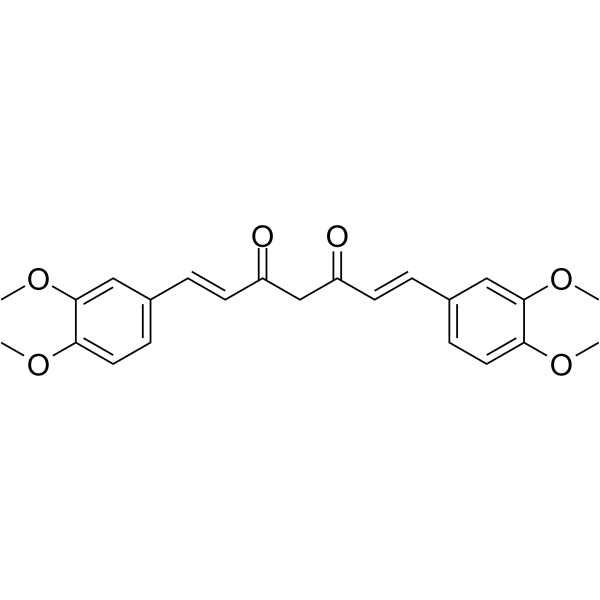
Dimethoxycurcumin
CAS No. 160096-59-3
Dimethoxycurcumin( Veratrylcurcuminoid )
Catalog No. M27175 CAS No. 160096-59-3
Dimethoxycurcumin is an analog of curcumin with more metabolical stability. Dimethoxycurcumin induces epigenetic changes in leukemia cells and the expression of promoter methylated genes.
Purity : >98% (HPLC)
 COA
COA
 Datasheet
Datasheet
 HNMR
HNMR
 HPLC
HPLC
 MSDS
MSDS
 Handing Instructions
Handing Instructions
| Size | Price / USD | Stock | Quantity |
| 2MG | 56 | Get Quote |


|
| 5MG | 87 | Get Quote |


|
| 10MG | 140 | Get Quote |


|
| 25MG | 264 | Get Quote |


|
| 50MG | 462 | Get Quote |


|
| 100MG | 672 | Get Quote |


|
| 200MG | Get Quote | Get Quote |


|
| 500MG | Get Quote | Get Quote |


|
| 1G | Get Quote | Get Quote |


|
Biological Information
-
Product NameDimethoxycurcumin
-
NoteResearch use only, not for human use.
-
Brief DescriptionDimethoxycurcumin is an analog of curcumin with more metabolical stability. Dimethoxycurcumin induces epigenetic changes in leukemia cells and the expression of promoter methylated genes.
-
DescriptionDimethoxycurcumin is an analog of curcumin with more metabolical stability. Dimethoxycurcumin induces epigenetic changes in leukemia cells and the expression of promoter methylated genes.
-
In Vitro——
-
In Vivo——
-
SynonymsVeratrylcurcuminoid
-
PathwayOthers
-
TargetOther Targets
-
RecptorAkt1| Akt2| Akt3| PKA
-
Research Area——
-
Indication——
Chemical Information
-
CAS Number160096-59-3
-
Formula Weight396.439
-
Molecular FormulaC23H24O6
-
Purity>98% (HPLC)
-
SolubilityIn Vitro:?DMSO : 100 mg/mL (252.25 mM)
-
SMILESCOc1ccc(\C=C\C(=O)CC(=O)\C=C\c2ccc(OC)c(OC)c2)cc1OC
-
Chemical Name——
Shipping & Storage Information
-
Storage(-20℃)
-
ShippingWith Ice Pack
-
Stability≥ 2 years
Reference
1.Blake JF, et al. Discovery and preclinical pharmacology of a selective ATP-competitive Akt inhibitor (GDC-0068) for the treatment of human tumors. J Med Chem. 2012 Sep 27;55(18):8110-27.
molnova catalog



related products
-
Triacanthine
Triacanthine which is a plant growth substance shows hypertensive and antitumor activity also cardiotonic antispasmodic and a respiratory analeptic.
-
beta-Nicotyrine
beta-Nicotyrine is a tobacco alkaloids Metabolite in the liver.
-
Bidenoside C
Bidenoside C is a flavonoid found in brazilian propolis, the first of its kind to be isolated from a herb of the genus Leech, and has anti-proliferative activity against cancer cells.



 Cart
Cart
 sales@molnova.com
sales@molnova.com


